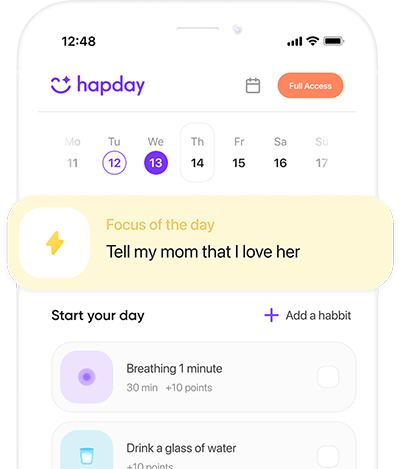We’ve all had those days. You’re stressed, sad, or maybe even bored, and before you know it, you’re reaching for comfort food—whether it’s a bag of chips, a pint of ice cream, or something equally tempting. This is emotional eating, and while it may offer a quick fix, the relief is usually temporary and can leave you feeling worse in the long run. The cycle of emotional eating can become a habit, one that’s tough to break.
Emotional eating is a common struggle. In fact, research from the American Psychological Association shows that 27% of adults turn to food to cope with stress. If this resonates, know that you’re not alone—and that with a few simple strategies, you can begin to break the cycle and build a healthier relationship with food.
Let’s dive into why emotional eating happens, how to identify the triggers, and practical steps to help you manage stress and emotions without turning to food.
Understanding Emotional Eating: Why We Do It
Emotional eating happens when we use food to cope with feelings rather than physical hunger. Whether it’s stress, boredom, loneliness, or frustration, food can offer temporary comfort. Eating activates the brain’s reward system, releasing feel-good chemicals like dopamine, which can make us feel better—briefly. But because it’s only a short-term fix, emotional eating can lead to guilt, shame, and, over time, health consequences.
Common Emotions that Trigger Emotional Eating:
- Stress: When stressed, the body releases cortisol, a hormone that can increase cravings for sugary, fatty foods.
- Sadness or Loneliness: Comfort foods provide temporary relief from these emotions by giving us a sense of pleasure or satisfaction.
- Boredom: Eating can be a way to “fill the time” when we feel aimless or unstimulated.
- Celebration and Reward: Emotional eating isn’t always about negative feelings. Sometimes, we associate food with celebrating or rewarding ourselves.
Understanding these triggers is the first step toward managing emotional eating. Once you recognize the connection between emotions and eating, you can begin to develop healthier responses.
1. Identify Your Triggers and Emotional Cues
The more aware you are of your emotional eating triggers, the easier it is to break the cycle. Start by observing what’s happening internally before, during, and after episodes of emotional eating. Are you feeling stressed, sad, or just bored? Becoming mindful of your triggers can help you pause and respond more thoughtfully.
Steps to Identify Emotional Eating Triggers:
- Keep a Food and Mood Journal: Write down what you’re eating, when, and how you feel at the time. Patterns will start to emerge.
- Notice Time of Day: Emotional eating often happens at specific times, like after work or late at night, when stress or fatigue peaks.
- Reflect on Your State of Mind: Ask yourself how you’re feeling before you reach for food. If it’s not hunger, what else could it be?
Example: If you notice that you often snack late at night, ask yourself if you’re actually hungry or just unwinding from a stressful day. Becoming aware of these patterns is the first step to changing them.
2. Practice Mindful Eating to Reconnect with Physical Hunger
Mindful eating can help you become more aware of the difference between physical hunger and emotional hunger. When you eat mindfully, you slow down, pay attention to your food, and enjoy each bite. This practice helps you stay tuned into your body’s hunger and fullness signals, making it easier to stop when you’re satisfied.
Tips for Mindful Eating:
- Pause Before Eating: Take a deep breath and check in with yourself. Are you physically hungry, or are you eating for another reason?
- Eat Slowly: Put down your fork between bites, chew thoroughly, and focus on the flavors and textures of your food.
- Remove Distractions: Try to eat without screens or other distractions. Being fully present helps you better enjoy your food and recognize when you’re full.
Example: If you’re craving a snack, pause and take a few deep breaths before eating. This small moment of mindfulness can help you make a conscious decision rather than automatically reaching for food.
3. Find Non-Food Alternatives to Cope with Emotions
Emotional eating often happens because food is the easiest comfort we have access to. But there are many other ways to manage stress, sadness, or boredom that don’t involve food. Finding alternative coping strategies can help you break the habit of reaching for food when emotions run high.
Non-Food Coping Strategies:
- Physical Activity: Exercise, even a short walk, can boost mood and reduce stress. It also releases endorphins, which naturally improve your emotional state.
- Creative Outlets: Activities like painting, writing, or playing music can be incredibly satisfying and offer a way to process emotions.
- Social Connection: Sometimes talking to a friend, partner, or family member can provide the comfort or distraction you’re looking for.
- Breathing and Relaxation Techniques: Deep breathing exercises or meditation can help calm your mind and reduce emotional cravings.
Example: The next time you feel stressed, try taking a quick 10-minute walk around the block. Physical movement helps release tension, and being outside can also help you reset emotionally.
4. Reframe Your Relationship with “Comfort Foods”
Many people have “comfort foods” that they associate with relaxation or reward. While there’s nothing wrong with enjoying favorite treats occasionally, it can help to reframe your mindset around these foods. Think of them as treats to be enjoyed in moderation, rather than the answer to stress or boredom.
Ways to Reframe Comfort Foods:
- Allow Treats Mindfully: Rather than eating in response to emotions, give yourself permission to enjoy a treat as part of a planned meal or snack.
- Create Positive Associations with Healthier Foods: Experiment with recipes and ingredients that are nourishing and enjoyable, so you’re not only associating “comfort” with high-sugar or high-fat foods.
- Separate Food from Emotions: Practice viewing comfort foods as an enjoyable experience, rather than a solution for difficult emotions.
Example: Instead of reaching for ice cream after a stressful day, save it for a planned occasion when you can fully enjoy it without guilt. This shift helps you separate food from emotional response and enjoy treats in a healthier way.
5. Practice Self-Compassion
Emotional eating often comes with guilt, shame, or negative self-talk. Instead of being hard on yourself, practice self-compassion. Acknowledge that emotional eating is a common response to stress and that change takes time. Self-compassion helps you avoid the cycle of guilt and shame that often leads to more emotional eating.
How to Practice Self-Compassion:
- Acknowledge Your Feelings: Recognize that emotional eating is a coping mechanism and that it’s okay to have these feelings.
- Avoid Judgment: If you slip up, don’t beat yourself up. Instead, view it as a learning opportunity and commit to trying again.
- Speak Kindly to Yourself: Treat yourself with the same compassion and understanding you would offer a friend going through the same struggle.
Example: If you find yourself eating out of boredom or stress, rather than criticizing yourself, try saying, “It’s okay. I’m working on better ways to cope, and I’ll get there.” This small act of kindness goes a long way toward breaking the guilt cycle.
6. Plan Ahead and Stock Up on Healthy Alternatives
When you’re stressed or emotional, it’s easy to reach for whatever is convenient—usually, that means processed snacks. Planning ahead and stocking up on healthier options can make it easier to make mindful choices, even when you’re in the throes of emotional cravings.
Steps for Healthy Planning:
- Stock Up on Healthy Snacks: Keep foods like nuts, fruit, yogurt, and veggies on hand. These options offer nutrition and are more satisfying than junk food.
- Prep Ahead: Take some time each week to prepare easy, balanced meals and snacks. Having nutritious food available reduces the temptation to reach for unhealthy options.
- Choose Satisfying Foods: High-fiber and protein-rich foods help keep you full longer and can satisfy cravings more effectively than sugary snacks.
Example: If you’re prone to afternoon snacking, keep a small container of mixed nuts or a piece of fruit at your desk. This way, if you feel the urge to snack, you have a healthy option within reach.
7. Get Professional Support When Needed
If emotional eating is a persistent struggle, it can be helpful to seek support from a therapist or counselor who specializes in emotional eating or behavioral therapy. Therapists can offer techniques for managing stress and help you better understand your relationship with food.
Therapies That Can Help:
- Cognitive Behavioral Therapy (CBT): CBT can help you identify and change thought patterns that lead to emotional eating.
- Mindfulness-Based Therapy: Mindfulness techniques can teach you to observe and accept emotions without reacting to them impulsively.
- Support Groups: Sharing your experiences with others facing similar challenges can provide community, accountability, and encouragement.
Example: If you’re struggling to control emotional eating on your own, consider reaching out to a therapist who can help you explore the deeper reasons behind your eating habits and give you practical tools to manage stress and emotions.
Building a Healthy, Balanced Relationship with Food
Overcoming emotional eating isn’t about never turning to food for comfort; it’s about developing a balanced relationship with food and finding healthier ways to cope with emotions. Emotional eating habits may take time to change, but each small step you take builds resilience and a better understanding of your triggers.
With mindfulness, self-compassion, and practical strategies, you can learn to manage emotions in a healthier way and create a new, more intentional relationship with food. Remember, it’s okay to have slip-ups along the way—what matters most is getting back on track and celebrating the progress you’re making. Each day is a new opportunity to take a positive step forward.
Build healthy eating habits with Hapday, Your Wellbeing Assistant
Join the millions of people using Hapday. Improve overall wellness & sleep.

Ready to transform your life? Install now ↴
Join 1M+ people using Hapday's AI-powered tools for better mental health, habits, and happiness. 90% of users report positive changes in 2 weeks.

